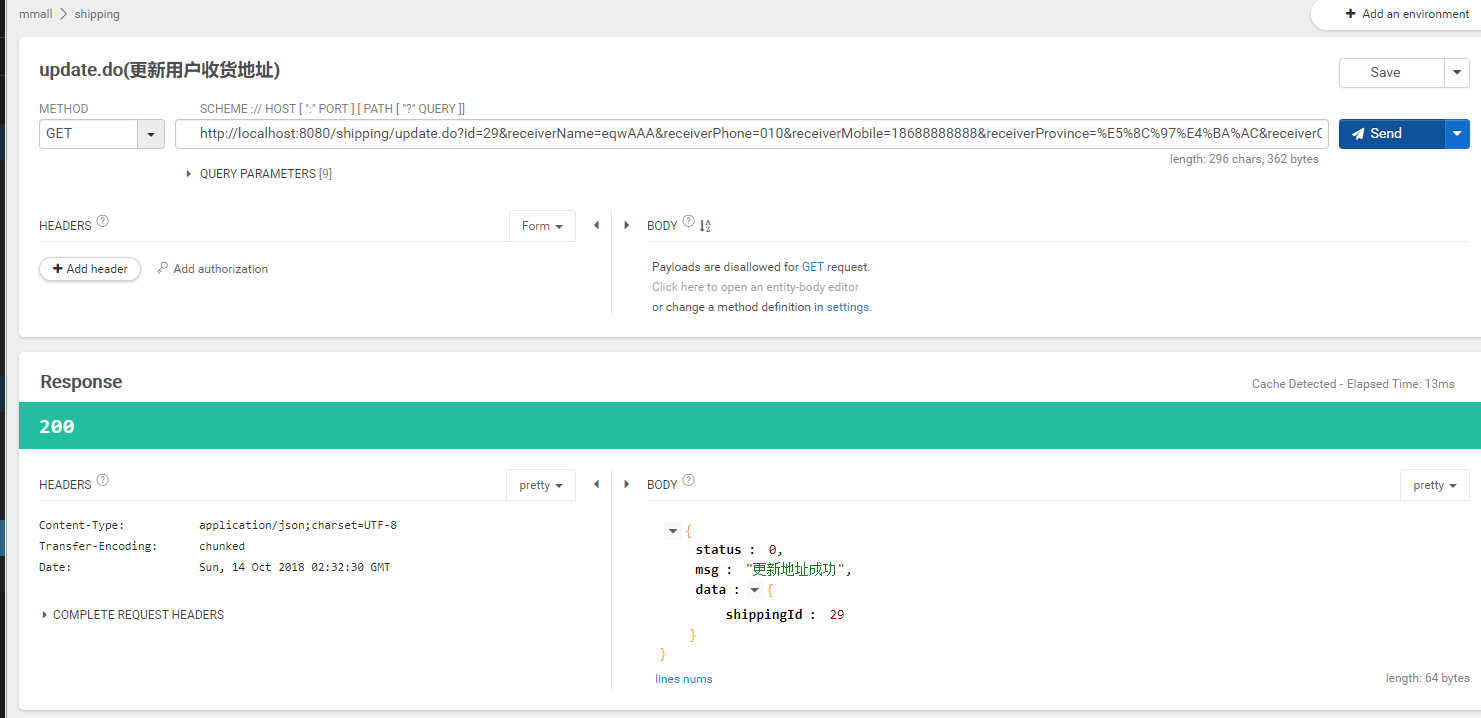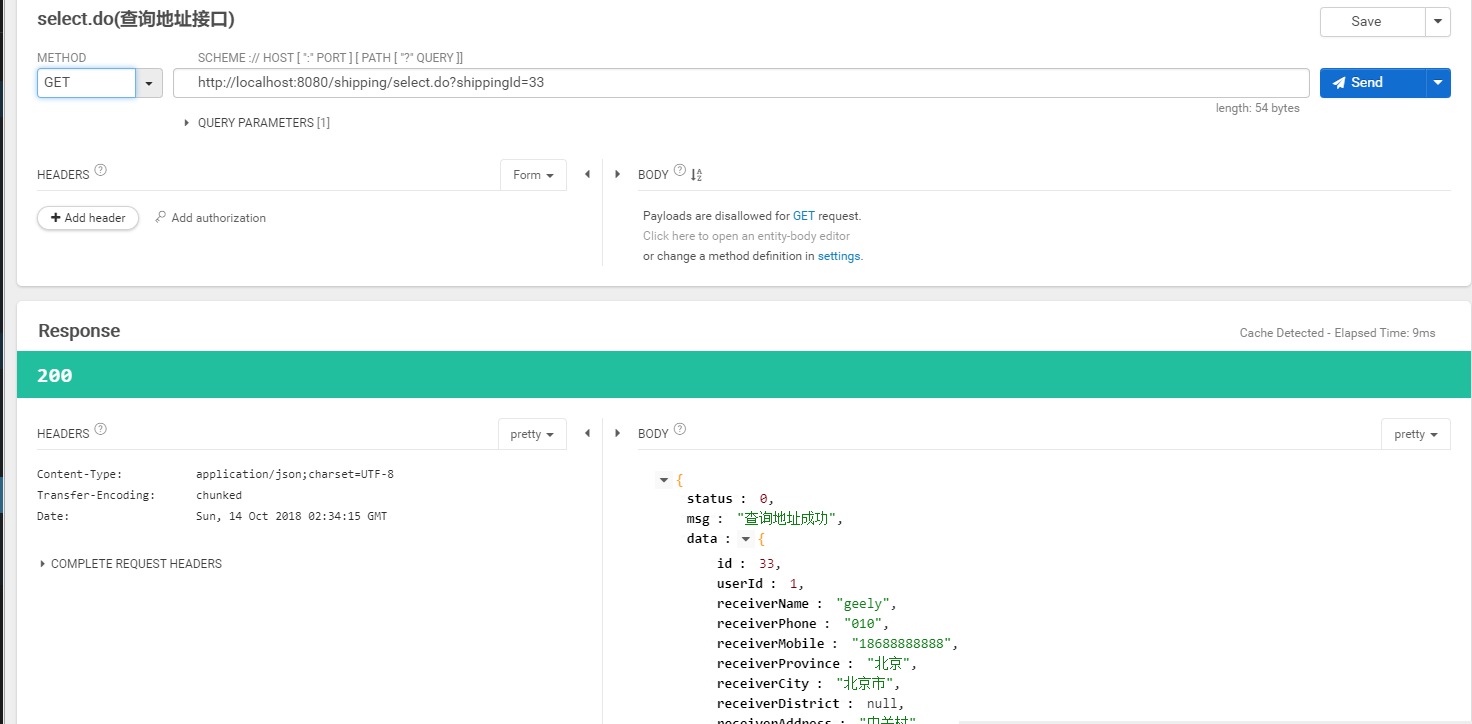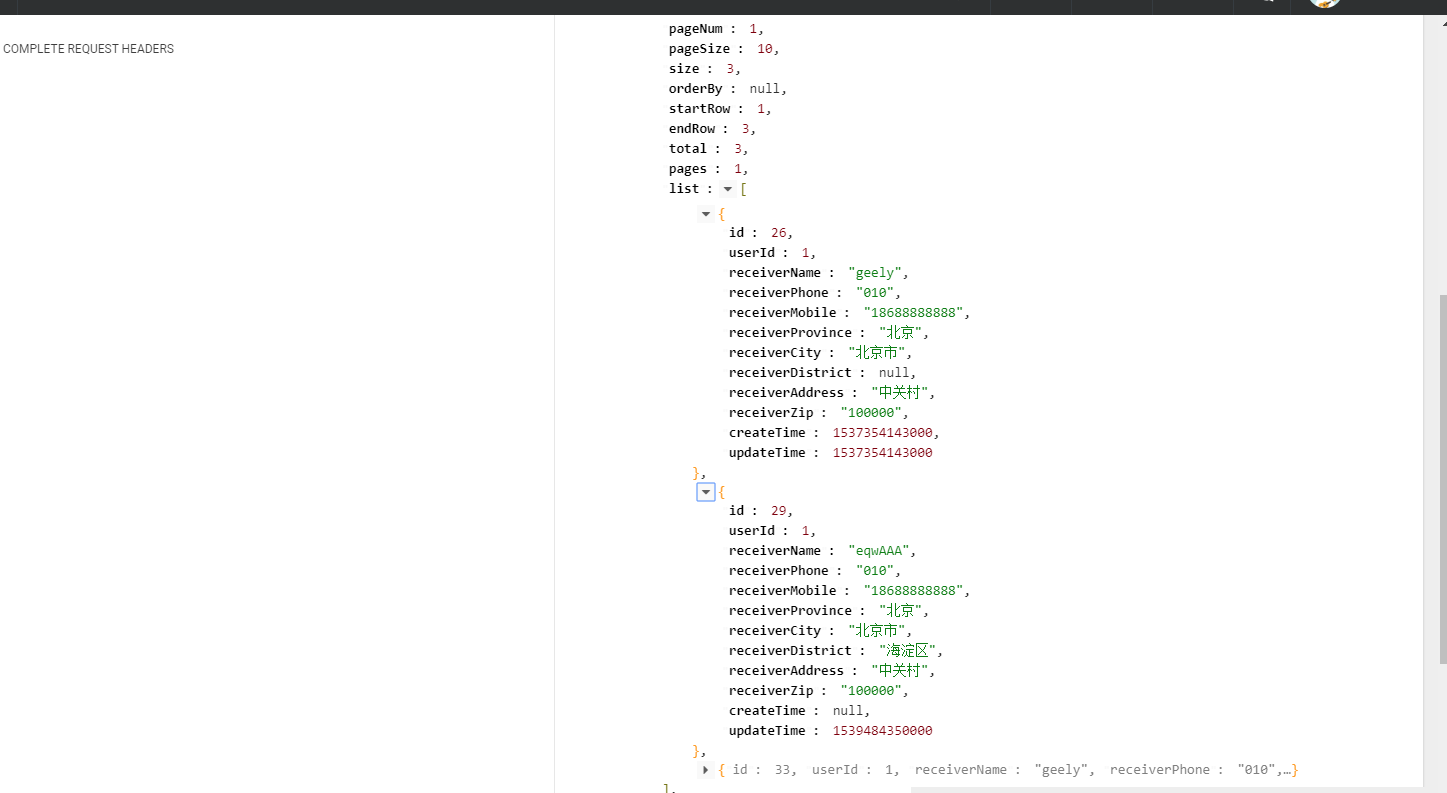22、【收货地址管理模块】
1、接口开发:
新建ShippingController类
 image.png在类上添加相关注解
image.png在类上添加相关注解
@Controller@RequestMapping(“/shipping/”)public class ShippingController { }1、收货地址的增加:
*Controller:
//添加地址接口 @RequestMapping(value = “add.do”) @ResponseBody public ServerResponse add(HttpSession session, Shipping shipping){ User user =(User) session.getAttribute(Const.CURRENT_USER); if(user == null){ return ServerResponse.createByErrorCodeMessage(ResponseCode.NEED_LOGIN.getCode(),ResponseCode.NEED_LOGIN.getDesc()); } return iShippingService.add(user.getId(), shipping); }
*Service:
//收货地址添加方法 ServerResponse add(Integer userId, Shipping shipping);
*ServiceImpl:
//收货地址添加方法 public ServerResponse add(Integer userId, Shipping shipping){ shipping.setUserId(userId); shipping.setCreateTime(new Date()); shipping.setUpdateTime(new Date()); int rowCount=shippingMapper.insertSelective(shipping); if(rowCount>=0){ Map result= Maps.newHashMap(); result.put(“shippingId”,shipping.getId()); return ServerResponse.createBySuccess(“新建地址成功”,result); } return ServerResponse.createByErrorMessage(“新建地址失败”); }
insertSelective是使用逆向工程生成的代码,所以直接调用即可。
2、收货地址删除的接口的开发:
*Controller:
//删除地址接口 @RequestMapping(value = “del.do”) @ResponseBody public ServerResponse del(HttpSession session, Integer shippingId){ User user =(User) session.getAttribute(Const.CURRENT_USER); if(user == null){ return ServerResponse.createByErrorCodeMessage(ResponseCode.NEED_LOGIN.getCode(),ResponseCode.NEED_LOGIN.getDesc()); } return iShippingService.del(user.getId(), shippingId); }
*Service:
//删除收货地址方法 ServerResponse del(Integer userId,Integer shippingId);
*ServiceImpl:
//删除收货地址方法 public ServerResponse del(Integer userId,Integer shippingId){ int rowCount=shippingMapper.deleteByShippingIdByUserId(userId,shippingId); if(rowCount>0){ return ServerResponse.createBySuccess(“删除地址成功”); } return ServerResponse.createByErrorMessage(“删除地址失败”); }
由于为了防止横向越权的问题,我们使用自己封装的deleteByShippingIdByUserId方法,在删除收货地址的时候,我们不仅判断收货地址的Id,同时还判断该收货地址是否是在当前用户下。*Mapper:
//同时根据用户Id和地址Id来删除地址,防止横向越权 int deleteByShippingIdByUserId(@Param(“userId”) Integer userId, @Param(“shippongId”) Integer shippongId);
*Mappler.xml:
delete from mmall_shipping where user_id=#{userId} and id=#{shippongId} 3、收货地址修改的接口编写:
*Controller:
//修改地址接口 @RequestMapping(value = “update.do”) @ResponseBody public ServerResponse update(HttpSession session, Shipping shipping){ User user =(User) session.getAttribute(Const.CURRENT_USER); if(user == null){ return ServerResponse.createByErrorCodeMessage(ResponseCode.NEED_LOGIN.getCode(),ResponseCode.NEED_LOGIN.getDesc()); } return iShippingService.update(user.getId(), shipping); }
*Service:
//修改地址接口 ServerResponse update(Integer userId,Shipping shipping);
*ServiceImpl:
//修改地址方法 public ServerResponse update(Integer userId,Shipping shipping){ shipping.setUserId(userId); Shipping selship=shippingMapper.selectByShippingIdByUserId(userId,shipping.getId()); if(selship == null){ return ServerResponse.createByErrorMessage(“该用户不存在此地址”); }else { int rowCount= shippingMapper.updateByshipping(shipping); if(rowCount>=0){ Map result= Maps.newHashMap(); result.put(“shippingId”,shipping.getId()); return ServerResponse.createBySuccess(“更新地址成功”,result); } } return ServerResponse.createByErrorMessage(“更新地址失败”); }
updateByshipping方法:*Mapper:
//修改地址接口 int updateByshipping(Shipping record);
*Mappler.xml:
update mmall_shipping set receiver_name = #{receiverName,jdbcType=VARCHAR}, receiver_phone = #{receiverPhone,jdbcType=VARCHAR}, receiver_mobile = #{receiverMobile,jdbcType=VARCHAR}, receiver_province = #{receiverProvince,jdbcType=VARCHAR}, receiver_city = #{receiverCity,jdbcType=VARCHAR}, receiver_district = #{receiverDistrict,jdbcType=VARCHAR}, receiver_address = #{receiverAddress,jdbcType=VARCHAR}, receiver_zip = #{receiverZip,jdbcType=VARCHAR}, create_time = #{createTime,jdbcType=TIMESTAMP}, update_time = now() where id = #{id,jdbcType=INTEGER} and user_id = #{userId,jdbcType=INTEGER} 4、查询地址接口:
*Controller:
//查询地址接口 @RequestMapping(value = “select.do”) @ResponseBody public ServerResponse select(HttpSession session, Integer shippingId){ User user =(User) session.getAttribute(Const.CURRENT_USER); if(user == null){ return ServerResponse.createByErrorCodeMessage(ResponseCode.NEED_LOGIN.getCode(),ResponseCode.NEED_LOGIN.getDesc()); } return iShippingService.select(user.getId(), shippingId); }
*Service:
//查询收货地址的方法 ServerResponse select(Integer userId,Integer shippingId);
*ServiceImpl:
//查询收货地址的方法 public ServerResponse select(Integer userId,Integer shippingId){ Shipping shipping=shippingMapper.selectByShippingIdByUserId(userId,shippingId); if(shipping == null){ return ServerResponse.createByErrorMessage(“无法查询到该地址”); } return ServerResponse.createBySuccess(“查询地址成功”,shipping); }
*Mapper:
“` //查询收货地址接口 Shipping selectByShippingIdByUserId(@Param(“userId”) Integer userId, @Param(“shippongId”) Integer shippongId);
*Mappler.xml:
select from mmall_shipping where id= #{shippongId} and user_id=#{userId} 5、查询所有地址接口开发(带分页):
*Controller:
//查询所有地址接口(带分页) @RequestMapping(value = “list.do”) @ResponseBody public ServerResponse list(@RequestParam(value = “pageNum”,defaultValue = “1”) int pageNum, @RequestParam(value = “pageSize”,defaultValue = “10”) int pageSize, HttpSession session){ User user =(User) session.getAttribute(Const.CURRENT_USER); if(user == null){ return ServerResponse.createByErrorCodeMessage(ResponseCode.NEED_LOGIN.getCode(),ResponseCode.NEED_LOGIN.getDesc()); } return iShippingService.list(user.getId(),pageNum,pageSize); }
*Service:
//查询所有收货地址的方法 ServerResponse list(Integer userId, int pageNum, int pageSize);
*ServiceImpl:
//查询所有收货地址的方法 public ServerResponse list(Integer userId,int pageNum, int pageSize){ PageHelper.startPage(pageNum,pageSize); List shippingList=shippingMapper.selectByUserId(userId); PageInfo pageInfo= new PageInfo(shippingList); return ServerResponse.createBySuccess(pageInfo); }
*Mapper:
//查询所有收获地址接口 List selectByUserId(Integer userId);
*Mappler.xml:
select from mmall_shipping where user_id=#{userId} 2、接口测试:1、收货地址接口测试 image.png2、收货地址删除的接口测试
image.png2、收货地址删除的接口测试 image.png3、收货地址修改的接口测试
image.png3、收货地址修改的接口测试 image.png4、查询地址接口测试
image.png4、查询地址接口测试 image.png5、查询所有地址接口测试
image.png5、查询所有地址接口测试 image.png
image.png image.png
image.png














